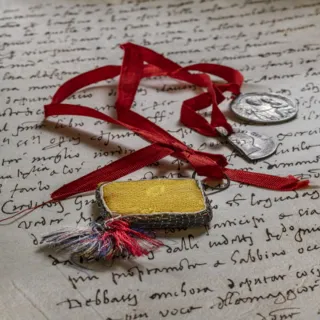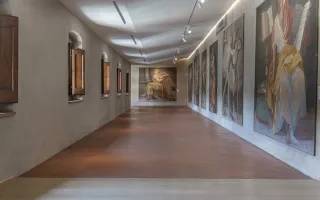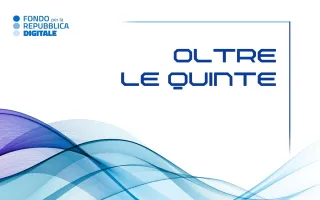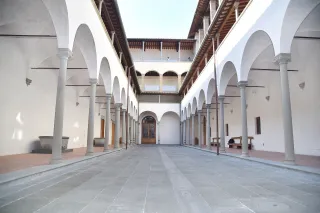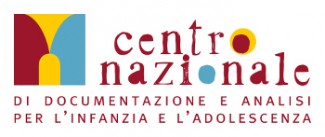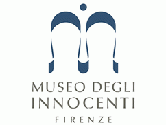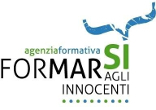And the Other Half I Shall Keep. From 4 November 2022 to 9 May 2023 at the Innocenti Museum
The exhibition dedicated to the tokens of the old Hospital, a selection of the 40,000 objects that accompanied the children when they entered the Institute, kicks off.
03 November 2022
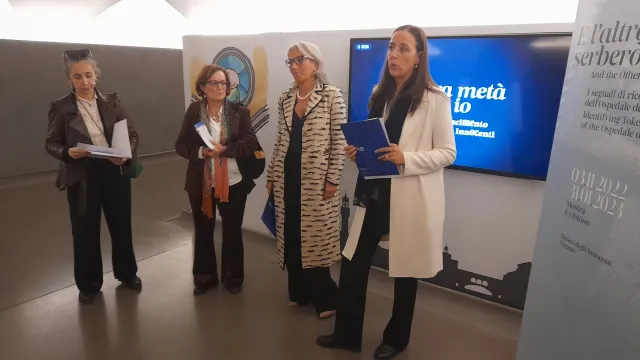
L'inaugurazione della mostra ''E l'altra metà serberò io''
And the Other Half I Shall Keep. The Tokens of the Ospedale degli Innocenti, the exhibition on the tokens - the small objects left with the boys and girls when they were entrusted to the Institute to ensure their survival - will be open from Thursday, 4 November until 9 May 2023 in the historical section (basement) of the Museo degli Innocenti in Florence. "I am extraordinarily pleased about the launch of this exhibition, first of all because it is a real journey through history and carries with it an important emotional charge," said Maria Grazia Giuffrida, Chairwoman of the Istituto degli Innocenti. "In addition, it is a significant way to recount the Institute's centuries-long commitment to the protection of children.
Finally, one of the Institute's objectives is to digitise the signs and the documentary material in order to make them available for consultation in the future and thus spread knowledge".
The Tokens
Coins and medals, but also votive accessories such as rosaries, medals and crosses, or everyday objects such as jewellery, buttons and ribbons. And from the Unification of Italy onwards, even images depicting Garibaldi and Victor Emmanuel II and green, white and red (the colours of the Italian flag) ribbons. Almost all the signs were broken, because they were, until 1875, the only 'identity documents' capable of reuniting parents with their children in the future by showing the missing parts. The Historical Archive of the Innocenti holds more than 40,000 signs, one of the richest collections of its kind in the world. The objects on display have been selected from this collection and are accompanied by illustrative panels, rigorously prepared from a scientific point of view but also accessible to the general public. This is because the aim of the exhibition is to disseminate knowledge of a unique heritage that needs to be protected, popularised and passed on to new generations.
The Exhibition Trail
Out of these 40,000 signs, 71 have been selected. Among them, visitors will be able to see for the very first time the oldest note kept in the Institute and never shown to the public before: Tommaso Domenico’s note left at the Institute on 21 December 1449. The result is a true journey through history from the unique perspective of abandoned children and the suffering of mothers and fathers who gave up parenthood to ensure a better future for their children.
Thousands of stories re-emerge from the Historical Archive thanks to the patient work of the Institute's archivists who have linked the signs with other archive sources such as, for example, the registers of Wet Nurses and Children. This register also describes what each child was wearing on arrival and the accompanying polizza, a piece of paper wrapped around the object used as a sign with information such as name or date of birth.
1449: Tommaso Domenico’s Note
Most signs date back to the beginning of the 19th century, presumably as a result of the reorganisation of the Scrittoio delle Creature in 1827, when they were wrapped in papers marked with the child's entry number and filed in small wooden boxes identified by year and month. However, the earliest signs are already documented in the 15th-century registers, noted down and stored in the chamberlain's room. This is the starting point of the exhibition that gives voice to the story of Tommaso Domenico who was abandoned at the Innocenti on 21 December 1449 with a note stating that he was the son of monna Domenica and asking that he be baptised as Tommaso. This is the oldest polizza that has been found so far in the Historical Archive.
1771: Little Riccarda's Half Coin
One of the oldest signs kept by the Institute, however, is that of little Riccarda, a girl who was about one year old when she was handed over to the Innocenti by a maid from the Compagnia del Bigallo on 6 February 1771 on the basis of an agreement between the two institutions whereby the brefotrofio degli Innocenti was responsible for gettatelli under three years of age. The little girl was wearing a medal of the Three Kings, an embroidered breve della Marca and a polizza with half a coin (the sign) in it. From the end of the 18th century, but especially at the beginning of the following century, the variety of objects expanded: in addition to coins and votive accessories, there were also everyday or typical objects of the time. According to religious and popular beliefs, many of these items were believed to be beneficial and to have 'magical' properties: devotional items, but also ribbons and corals, jewellery and anything that glittered would protect children from dangers and the evil eye.
1861: The Unification of Italy and the Medals of Garibaldi and Victor Emmanuel II
In 1861, the year of the Unification of Italy, as many as 1,477 signs were left to more than half of the children who were probably legitimate offspring who could be taken back by their families. There were also new objects such as medals depicting Garibaldi, Victor Emmanuel II or Napoleon III. The colours of the Italian flag (green, white and red) featured in ribbons, and various polizze asked for children to be given evocative names such as Italia, Cammillo, Garibaldo or Vittorio Emanuelle. These items also include the sign of little Tecla, who arrived at the Innocenti on 24 July 1861 wearing the diagonal half of a silver medal with the effigy of Garibaldi.
1875: The Grated Window Closes and the Delivery Office Opens
The use of tokens diminished with the closure of the Grated Window (30 June 1875), and the opening of the Delivery Office to receive illegitimate children marked the introduction of new administrative procedures for their recognition through Court rulings. The custom of leaving babies with an object was, however, so deeply rooted that it survived well beyond the 20th century. Although now superfluous for recognition, 20th-century signs still included broken objects, even though their value was exclusively sentimental and symbolic. Examples are those carried by little Flora, left as a newborn at the Innocenti in April 1901. She had half a golden cross with her mother keeping the other half, and a poem full of tenderness: To you, oh Flora. They were both kept at the Hospital although signs were no longer needed for child recognition.
Tokens, Registers and Filze. Archive Work and the Delicate Art of Reconstructing Children's Stories
Each personal story can be reconstructed from the children’s data recorded in the registers of Wet Nurses and Children that describe what they were wearing on arrival: their clothes, their signs and any accompanying polizza. The polizze, in turn, were kept in filze, collections of papers threaded with string and once called Polizze di bambini (Children’s polizze). While children were growing up, all those events that required intervention by the Administration or other authorities were documented, as shown by the correspondence collected in Affari per Creature.
Finally, a child’s history can be enriched by consulting the Hospital's Baptismal Registers (Registri di battesimo), the Books of the Dead, (Libri dei morti) where the deaths of the children were recorded, or even the Books of Wet Nursing (Libri del baliatico) and those of the Peoples (Libri de’ popoli) for information on wet nurses. This is also how the story of little Gastone was reconstructed. He was a two-day-old infant who arrived at the Delivery Office on 17 August 1886 and had for a sign the upper half of a tin medal strung on a blue ribbon. Born of unknown parents, he was accompanied by a midwife from Figline carrying the documents that were then necessary to be accepted by the brefotrofio: his birth certificate, issued by the Registry Office, and a baptismal certificate showing Gastone as his name. The baby was immediately entrusted to Ester in the Mugello Valley in order to be breastfed. He was subsequently assigned to Maria for weaning, and remained with her for about six years. It was only in 1905 that, for undocumented reasons, Gastone was called back to the Innocenti to await a new placement.
Tino the Nocentino: Animated Slides and a Space for the Younger Ones. The Tokens Narrated to the Children.
And the Other Half I Shall Keep. The Recognition Signs of the Ospedale degli Innocenti is also an exhibition for children. There is a space dedicated to the younger ones where, by projecting animated slides, Tino il Nocentino comes alive and speaks. Tino is one of the protagonists of The Broken Coin: A Story by Tino il Nocentino, a publication in Italian and English (with illustrations by Simone Frasca and texts by Sara Marconi) specifically designed to accompany the younger ones through the exhibition, and created thanks to the support of the Foundation Istituto degli Innocenti Ets.
The animated slides draw inspiration from the story of the accidental finding of a broken coin in a cupboard by two little siblings, Anna and Martino, who immediately run to their grandmother to ask about the discovery. This is the starting point of a child-friendly journey back in time in the history of the Innocenti, with Tino il Nocentino, a child who was taken into the old hospital, acting as narrator together with his grandmother.
Recovery, Restoration and Digitisation. The Future of the 40,000 Tokens.
One of the Institute's objectives is to ensure the preservation, protection and popularisation of more than 40,000 signs, through the archival reorganisation and inventorying of the objects and documents connected with them (children's Hospital admission registers). One of the Institute's objectives is to digitise the documentary material. The images that have been created and their metadata will be placed in a digital showcase that will allow them to be viewed and consulted from the web, thus spreading this knowledge.
The exhibition And the Other Half I Shall Keep. The Tokens of the Ospedale degli Innocenti has also been designed to make visitors aware of the great conservation project the Institute intends to launch thanks to the Foundation Istituto degli Innocenti Ets that will support this project with fundraising initiatives (for donations, visit www.fondazioneinnocenti.it).
The total duration of the project is estimated to be about ten years from 2023 and includes reordering, digitising and publishing about 4,000 items per year.
Last update: 02/08/2023 - 10:40

